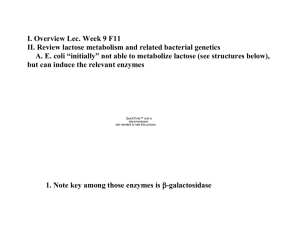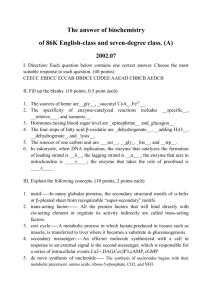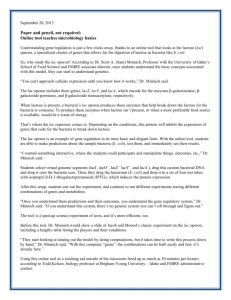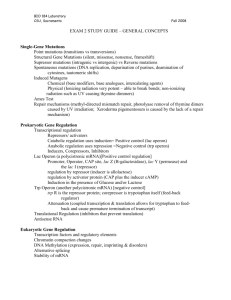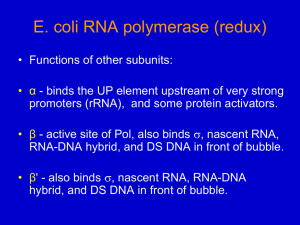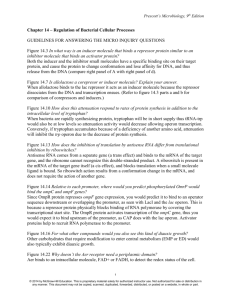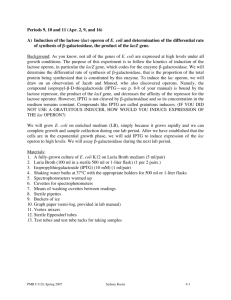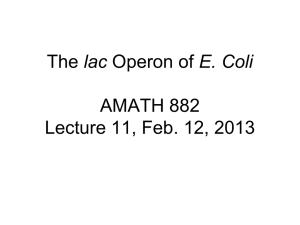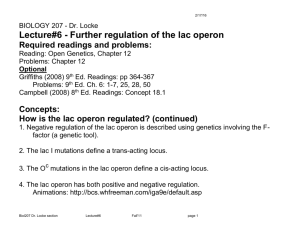bistability and hysteresis in epigenetic regulation of the lactose
advertisement
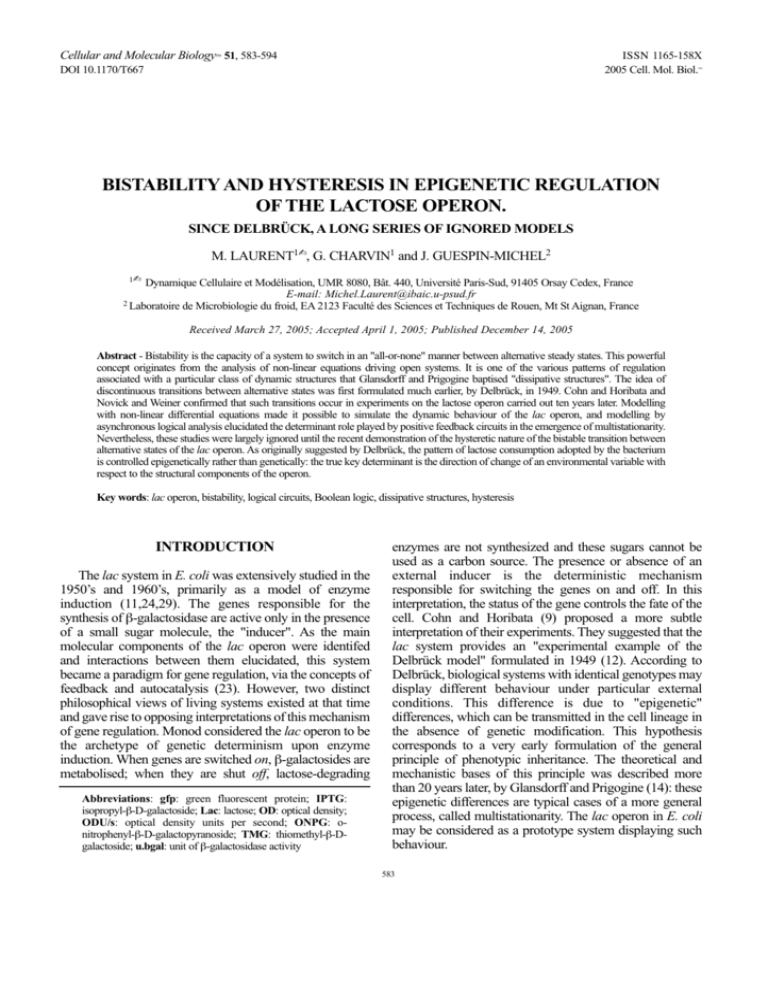
Cellular and Molecular Biology 51, 583-594 ISSN 1165-158X 2005 Cell. Mol. Biol. TM DOI 10.1170/T667 TM BISTABILITY AND HYSTERESIS IN EPIGENETIC REGULATION OF THE LACTOSE OPERON. SINCE DELBRÜCK, A LONG SERIES OF IGNORED MODELS M. LAURENT1✍, G. CHARVIN1 and J. GUESPIN-MICHEL2 1✍ Dynamique Cellulaire et Modélisation, UMR 8080, Bât. 440, Université Paris-Sud, 91405 Orsay Cedex, France E-mail: Michel.Laurent@ibaic.u-psud.fr 2 Laboratoire de Microbiologie du froid, EA 2123 Faculté des Sciences et Techniques de Rouen, Mt St Aignan, France Received March 27, 2005; Accepted April 1, 2005; Published December 14, 2005 Abstract - Bistability is the capacity of a system to switch in an "all-or-none" manner between alternative steady states. This powerful concept originates from the analysis of non-linear equations driving open systems. It is one of the various patterns of regulation associated with a particular class of dynamic structures that Glansdorff and Prigogine baptised "dissipative structures". The idea of discontinuous transitions between alternative states was first formulated much earlier, by Delbrück, in 1949. Cohn and Horibata and Novick and Weiner confirmed that such transitions occur in experiments on the lactose operon carried out ten years later. Modelling with non-linear differential equations made it possible to simulate the dynamic behaviour of the lac operon, and modelling by asynchronous logical analysis elucidated the determinant role played by positive feedback circuits in the emergence of multistationarity. Nevertheless, these studies were largely ignored until the recent demonstration of the hysteretic nature of the bistable transition between alternative states of the lac operon. As originally suggested by Delbrück, the pattern of lactose consumption adopted by the bacterium is controlled epigenetically rather than genetically: the true key determinant is the direction of change of an environmental variable with respect to the structural components of the operon. Key words: lac operon, bistability, logical circuits, Boolean logic, dissipative structures, hysteresis INTRODUCTION The lac system in E. coli was extensively studied in the 1950’s and 1960’s, primarily as a model of enzyme induction (11,24,29). The genes responsible for the synthesis of β-galactosidase are active only in the presence of a small sugar molecule, the "inducer". As the main molecular components of the lac operon were identifed and interactions between them elucidated, this system became a paradigm for gene regulation, via the concepts of feedback and autocatalysis (23). However, two distinct philosophical views of living systems existed at that time and gave rise to opposing interpretations of this mechanism of gene regulation. Monod considered the lac operon to be the archetype of genetic determinism upon enzyme induction. When genes are switched on, β-galactosides are metabolised; when they are shut off, lactose-degrading Abbreviations: gfp: green fluorescent protein; IPTG: isopropyl-β-D-galactoside; Lac: lactose; OD: optical density; ODU/s: optical density units per second; ONPG: onitrophenyl-β-D-galactopyranoside; TMG: thiomethyl-β-Dgalactoside; u.bgal: unit of β-galactosidase activity enzymes are not synthesized and these sugars cannot be used as a carbon source. The presence or absence of an external inducer is the deterministic mechanism responsible for switching the genes on and off. In this interpretation, the status of the gene controls the fate of the cell. Cohn and Horibata (9) proposed a more subtle interpretation of their experiments. They suggested that the lac system provides an "experimental example of the Delbrück model" formulated in 1949 (12). According to Delbrück, biological systems with identical genotypes may display different behaviour under particular external conditions. This difference is due to "epigenetic" differences, which can be transmitted in the cell lineage in the absence of genetic modification. This hypothesis corresponds to a very early formulation of the general principle of phenotypic inheritance. The theoretical and mechanistic bases of this principle was described more than 20 years later, by Glansdorff and Prigogine (14): these epigenetic differences are typical cases of a more general process, called multistationarity. The lac operon in E. coli may be considered as a prototype system displaying such behaviour. 583 584 M. Laurent et al. FEEDBACK LOOP IN THE MECHANISM OF REGULATION OF THE LAC OPERON The lactose operon comprises three adjacent genes, lacZ, lacY and lacA, under the control of a single promoter. These genes are co-transcribed as a polycistronic messenger RNA. The proteins encoded by the two first genes are involved in the uptake and degradation of lactose and related sugars (Fig. 1). Immediately upstream from the lac operon is a regulatory domain in which the lacI gene encodes a constitutively expressed transcriptional regulator, the lactose repressor lac. The repressor interacts closely with several operator sites on the DNA, preventing the binding of the RNA polymerase and subsequent transcription of the lac operon. LacZ encodes β-galactosidase, an enzyme responsible for lactose degradation. Another mechanism converts lactose into its isomer, allolactose. Allolactose is the natural inducer of the system: it binds to the lactose repressor and changes its conformation, causing this protein to loosen its hold on the DNA, thereby facilitating transcription of the operon. The product of lacY is a specific permease that promotes the passage through the membrane of lactose and some related β-galactosides. Regulation of the lac operon appears to be autocatalytic: the permease promotes the passage of lactose through the membrane. This results in an increase in the intracellular concentration of inducer and, subsequently, the production of more permease. However, if the external concentration of the inducer is high enough (which is the case in most experimental conditions), diffusion through the cell envelope is sufficient to promote its entry. Lactose is thus both the inducer of the system and a source of carbon and energy for cells. These two functions may be experimentally uncoupled, using gratuitous inducers such as TMG and IPTG. These molecules enter the cell via the lactose permease. They bind to the lac repressor but are not metabolised. The uptake of IPTG therefore induces the synthesis of LacY, which in turn promotes further IPTG uptake (if the external concentration is low). Hence, gratuitous inducers can be used to study the specific effect of the feedback loop on regulation of the lac operon. THE KEY EXPERIMENTS OF NOVICK AND WEINER AND COHN AND HORIBATA AND DISCOVERY OF THE "MAINTENANCE" EFFECT Novick and Weiner (27) and Cohn and Horibata (8-10) discovered what they described as a ‘maintenance effect’. As a consequence of the mechanism of enzyme induction, a single cell may have two alternative states: induced, in which it can metabolise lactose, or uninduced, in which the Fig. 1 Schematic representation of the rationale of the operon model. a) Transcription of the operon is repressed by the binding of the Lac repressor (encoded by lacI) to the lac operator, a pseudo-palindromic sequence centred 11 bp downstream from the transcription start site (25). This interaction prevents the binding of RNA polymerase, thereby blocking transcription of the operon. This operon also has an activator site, which binds to the cAMP-CRP complex, resulting in the activation of transcription. This mechanism is involved in catabolic repression. b)Asmall sugar molecule (the artificial inducer IPTG or the natural inducer allolactose) binds to the Lac repressor protein and decreases the strength of the repressor-operator DNA interaction. One of the genes of the operon, lacY, encodes a specific permease that promotes the passage through the membrane of both β-galactoside and inducer. c) At the cellular level, this results in an increase in intracellular inducer concentration and the production of more permease, in an autocatalytic manner. corresponding genes are switched off and lactose metabolism does not occur. However, the key experiments of these pioneering authors involved switching on an entire cell population, rather than a single cell. The protocol was as follows (Fig. 2) a large amount of inducer was added to the extracellular medium of a culture of uninduced E. coli cells. The culture was split into two parts: U (uninduced) and I (induced). Part U was immediately diluted, resulting in an immediate large decrease in extracellular inducer concentration. Part I was diluted after being maintained in the medium with high inducer concentration for several minutes. The cells in subculture U remained uninduced Bistability in lac operon regulation whereas those in subculture I were induced. Growing subcultures were then serially diluted with medium containing a low concentration of inducer: U remained uninduced and I, induced. The range of external inducer concentrations at which both induced and uninduced cells may be present was called the "maintenance" concentration by Novick and Weiner. The "maintenance effect" was interpreted as the consequence of a high permease concentration in induced cells, which would also have high inducer pumping efficiency. This would enable these cells to maintain the induced state and to transmit it to their progeny, even if placed in a medium with a low concentration of inducer. This interpretation accounts for the existence of two distinct phenotypes and provides an explanation as to why induced cells placed in media with low inducer concentrations remain indefinitely induced, whereas cells that have never been induced stayed uninduced at this low concentration of inducer. However, it does not explain what makes the cells switch between alternative states. Even Delbrück, with his renowned intuition, could provide no explanation for this switching, which remained a mystery until the thermodynamic and mechanistic bases of dynamic systems were described in 1971, by Glansdorff and Prigogine (14). The next 585 challenge was to determine how a graded signal (the extracellular concentration of inducer) could be converted into discontinuous changes in gene expression. An understanding of this conversion is required to explain how a phenotypic change (an all-or-none transition) in the behaviour of the lac operon can be inherited following a transient signal – exposure to a high concentration of allolactose. This situation corresponds to the modern concept of bistability – the capacity of a system to achieve alternative steady states in response to a single set of inputs and its ability to switch between these states in response to a signal. BISTABILITY DUE TO THE EXISTENCE OF A NON-LINEAR FEEDBACK LOOP The modelling of relevant processes was required to unravel the dynamics of lac operon regulation. Babloyantz and Sanglier (4) and Nicolis and Prigogine (26) proposed a dynamic model for interpretation of the ‘maintenance effect’ as the biological facet of the physical process of multistability. This model, involving a non-linear feedback loop, accounted for the main behavioural features of the bistable transition of the lactose operon. However, even though the mathematical description of the model required five differential equations (plus one conservation equation), the model did not take into account the detailed information available concerning molecular interactions between components. Fortunately, not all the details are needed. This non-linear feedback loop has consequences for the dynamics of lac operon regulation. LOGICAL ANALYSIS OF THE EPIGENETIC REGULATION OF THE LACTOSE OPERON Fig. 2 The key experiment of Novick and Weiner (27) and Cohn and Horibata (9) demonstrating the existence of a "maintenance" range of concentrations of the inducer. A high amount of inducer was added into the extracellular medium of a culture of uninduced E. Coli bacterial cells. A part of the culture (part U, uninduced) was immediately diluted, so that the extracellular concentration of inducer dropped to a small value for the corresponding cells. On the contrary, part I (induced) of the culture was maintained during several minutes into the medium containing highly concentrated inducer. Only cells maintained for long periods in the presence of a high concentration of inducer are induced. If induced cells are transferred to a medium with the "maintenance concentration" of inducer, they – and their progeny – remain induced. Similarly, if uninduced cells are transferred to a medium with the "maintenance" concentration, they – and their progeny – remain uninduced. See the main text for a precise description of this experiment demonstrating the maintenance of two stable steady states of β-galactosidase synthesis are maintained by a genetically homogeneous population growing in a fixed medium (8). The models described above have frequently been ignored by scientists working on the lac operon. A recent paper (28), for example, starts afresh building on the work of Novick and Wiener (27) and Cohn and Horribata (9). It is therefore clear that the theoretical studies carried out over the last forty years or so, since the work of Glansdorff and Prigogine (14) have made little impact on the biological community. Indeed, even the papers by Novick and Wiener (27) and Cohn and Horribata (9) have been largely ignored. They are absent from most, if not all, manuals and treatises of molecular biology and bacterial genetics, in which the lactose operon remains the paradigmatic example of gene regulation. The role and presence of the permease are often omitted from short descriptions of the lactose operon. It may be that biological training does not include enough mathematics to enable biologists to manipulate with ease the non-linear differential equations required to model and therefore to 586 M. Laurent et al. explain experiments showing epigenetic modifications? However, modelling requiring much less mathematical knowledge (logical analysis) received no more attention from biologists until quite recently. Fig. 3 Classical and asynchronous Boolean analysis of a simple circuit. a) Logical graph of a two-variable positive circuit. b) State table corresponding to classical (resp. asynchronous) Boolean analysis of the above circuit. c) Classical Boolean state graph. d) Asynchronous Boolean state graph (see text). In his early modelling work, René Thomas focused on the epigenetic modifications following infection of Escherichia coli with phage lambda. However, as early as 1973 (35), he suggested that Boolean logic could be used to model the dynamic behaviour of the lactose operon. He later gave a detailed explanation of the subject (37). The use of Boolean algebra for modelling the dynamic behaviour of biological interactions is based on the typically sigmoidal shape of these interactions, making it possible to simplify them as all-or-none phenomena: for example, a protein concentration may be below (0) or above (1) its threshold of activity, and a gene may be expressed strongly enough to produce an amount of protein above (1) or below (0) its threshold of activity. This simplification amounts to transforming a sigmoid into a step function (39). A logical graph represents the interactions (Fig. 3). In the classical, synchronous Boolean equation, the positive regulation of a gene y by a protein x is denoted y(t+1) = x(t), with the vertex on the graph marked by a ‘plus’ sign, whereas negative regulation is denoted y(t+1)= *x(t), with the vertex on the graph marked with a ‘minus’ sign The very simple graph in Fig. 3a shows that x positively regulates y, which in turn positively regulates x. The classical Boolean equation is: x(t+1) = y(t) y(t+1) = x(t) Values for these variables can be determined with a state table (Fig. 3b), in which the left column contains all the possible combinations of values for the variables at time t and the right column, the corresponding values of the variables at time t+1. The lines in which the figures are equal in both columns correspond to states in which the system is not changing (stable states). Fig. 3b shows two stable states: 11 and 00. This state table can be converted into a graph of states displaying the dynamics of the system starting from any initial condition (Fig. 3c). There are two stable states (00 and 11), and one oscillation 01 ➝ 10 ➝ 01. Biologically, this means that if the initial condition is 01 (protein x below its threshold, protein y above its threshold), the next step will be 10. However, there is no reason why the synthesis of protein x, once the gene is activated, should take the same time as the disappearance of protein y. Indeed, the turnover of a protein is generally slower than its synthesis. This led Thomas to propose "asynchronous logic" (38), in which the variable xi corresponds to the proteins, and the function Xi corresponds to the expression of the corresponding gene: X=y Y=x As in the classical formalism, if the values in both columns of the state table are identical, a stable state has been reached. In Fig. 3b, states 00 and 11 are the stationary Bistability in lac operon regulation states. However, in this case, state 01 is followed either by the expression of gene X (corresponding to the synthesis of protein x above it’s threshold, state 11) or the repression of gene Y followed by a decrease in the amount of protein y to below it’s threshold (state 00) (Fig. 3d). There is no more oscillation. The use of asynchronous logic enabled Thomas to obtain qualitative results similar to those obtained with differential equations, despite the gross simplifications it involves (39). The main advantage of this method, apart from its great simplicity, is that it does not require values for the parameters (which are lacking in most biological situations), to determine the qualitative dynamic behaviour of the system. Indeed, the very simple logical equation in Fig. 3 may be sufficient to describe the bistability property of the lactose operon. Let y be the permease, Y the expression of the lacY gene (corresponding to expression of the entire operon), x the internal concentration of inducer (X corresponds to the entry of the inducer). As the LacI protein is constitutively synthesised, it is not required as a variable of the system. If the gratuitous inducer is at maintenance concentration, the permease allows the entry of inducer (X = y), which inhibits LacI, leading to the expression of lacY (and thus the synthesis of permease) (Y= x). In these conditions, there are two stable states: 00 (the uninduced phenotype, neither permease, nor internal inducer), and 11 (induced phenotype). It is very easy to account for the effect of high concentrations of external inducer. Let us represent the external inducer concentration as parameter E (E = 1 if the external inducer concentration is high enough to allow diffusion through the envelopes, E = 0 if the inducer concentration is lower). The logical state equation becomes: Y = x +E X=y When E=0, the table is identical to that shown in Fig. 3b, and there are two possible stable states. When E=1, protein LacI is always inactive and gene lacY is always expressed (Y=1), so there is only one stable state, the induced state (Fig. 4) Thomas (37) also showed that this method could be used to simulate the more complicated situation in which lactose is both the inducer and the carbon source, resulting in its disappearance from the medium. This very simple graph clearly illustrates the properties of the system, as described by Novick and Weiner (27) and Cohn and Horibata (9). For instance, if the inducer concentration is increased from maintenance concentration to high concentration (Fig. 4), we shift from column 2 to column 3 (E = 1). If the stable state was the uninduced state, then we observe a shift to the induced state, 11. A subsequent decrease in inducer concentration (back to 587 column 2) does not change the new stationary state. Thus, in an uninduced population, a transient increase in the concentration of the inducer shifts the system to the permanently induced state. This method made it possible for Thomas to demonstrate the existence of positive feedback loops in this system. As explained above, bistability occurs because the system is non-linear and contains a positive feedback circuit. An extensive use of this method led Thomas to realise that what is common to all the cases of bistability was the presence of a positive feedback circuits (e.g. circuit with an even number of negative interactions). He postulated that the existence of a positive feedback was not only the simplest way to generate multistationnarity, but in fact a necessary condition of multistationnarity (and that negative feedback circuits are required for homeostasis with or without oscillations) (36). This conjecture was later studied by mathematicians, who showed it to be true for non-linear systems with sigmoid interactions (7,16,30,32), and for non-linear conditions in general (34). It was also recently shown (2) that frequently satisfied mathematical conditions guaranteed multistability in positive-feedback systems of arbitrary order. In addition, Thomas showed that a single positive circuit, regardless of it’s length, can only generate two stable and one unstable steady state. To achieve multistationarity with a larger number of stationary states, a system must have more independent positive circuits; the number of steady states cannot exceed 3n (with 2n stable states), if n is the number of circuits. This theorem has two major consequences for studies of regulatory networks. Firstly, a regulatory network must Fig. 4 Modelling the dynamic behaviour of the lactose operon with asynchronous logical methods The state table corresponds to the asynchroneous Boolean equation: X=y+E Y=x where x = the permease, X = the expression of gene lacY, y = the internal inducer, Y = the entry of the external inducer, and E stands for an external inducer concentration high enough (E=1) or too low (E=0) to allow passive diffusion through the membrane (see text for explanations). 588 M. Laurent et al. contain a positive feedback circuit if it is to display multistationarity (just as the presence of a negative feedback circuit is a prerequisite for oscillations). Thus, although all of the interactions in a network are important, those involved in circuits are the key interactions for understanding the dynamics of the system, and the presence of such circuits in a system may lead to the formulation of new hypotheses concerning the behaviour of the system (17,19). Secondly, as these circuits are necessary but not sufficient for multistationarity, an experimental demonstration of the phenomenon is needed. Such a demonstration can be facilitated by computer analysis of the logical model (6). Since their early research, Thomas and his co-workers (32) have developed a more comprehensive logical method and determined more precisely the conditions required for multistationarity (40). Both the naïve logical method and general asynchronous analysis can be used to model the dynamic behaviour of biological systems with positive feedback loops (13,31,41). Comparative differential model of regulation of the lactose operon The rate of change over time in the intracellular concentration of inducer [ai] corresponds to the algebraic difference between the rate of the process producing intracellular inducer (vin) and that of the processes removing this species (vout). net rate = d[ai]/dt = vin - vout Eq. 1 Free intracellular inducer is depleted in several processes (binding of the inducer to the repressor, catabolism and dilution following cell division). As none of these removal processes is regulated by ai, the corresponding rates may be assumed to be simply proportional to [ai]: vout = kout [ai] Eq. 2 where kout is a first-order rate constant. The rate of production of intracellular inducer, vin, is proportional to the concentration of inducer in the extracellular medium ([ae]). However, as stated above, intracellular inducer facilitates the transcription of permease, and permease promotes the transport of inducer from the external medium into the bacterial cell. Therefore, the intracellular inducer indirectly activates the entry of external inducer into the cell. For a given concentration [ae] of external inducer, the rate, vin, displays a sigmoidal dependence on [ai], indicating both the existence of a saturating phenomenon and the non-linearity of the response. This is well approximated by an empirical Hilllike equation (21,22): [a i ]n vin = [a e ] k 0 + K + [ai ]n Eq. 3 The parameter k0 in Eq. 3 corresponds to passive diffusion of the inducer throughout the cell membrane. In the absence of this phenomenon (or in absence of a basal level of protein synthesis in the absence of inducer), there would be no permease at all and the first molecule of inducer could never enter the cell, preventing permease synthesis. Indeed, basal transcription was found experimentally to correspond to the presence in the cell of 1 to 10 molecules of β-galactosidase in the absence of inducer (15). In Eq. 3, the non-linearity of the dependence of the rate vin on intracellular inducer concentration [ai] is crucial (see Fig. 5 below). According to Muller et al. (25) and Ozbudak et al. (28), this non-linearity is due to binding of the inducer to the LacI tetramer (co-operative binding with a Hill number n close to 2). More generally, Vilar et al. (42) suggested that the rate of production of permease is a nonlinear function of intracellular inducer concentration. Whatever the molecular basis of the co-operative phenomenon in regulation of the lac operon, the consequence is that the intracellular inducer exerts nonlinear, positive feedback, controlling its own entry. Fig. 5 shows the dependence of vin and vout on intracellular inducer concentration [ai]. There are three ai concentrations for which vin = vout. These particular values of [ai] define three steady states (SS1, SS2 and SS3) for the system because, in each, [ai] does not change with time (d[ai]/dt = vin - vout = 0). Small fluctuations disappear around the SS1 and SS3 steady states corresponding to extreme values of [ai], whereas they are amplified around the intermediate SS2 steady state (Fig. 5). Thus, SS1 and SS3 act as attractors (they are stable steady states) whereas SS2 behaves like a repellent (it is unstable). The lac operon therefore behaves like a bistable system, with the two stable steady states separated by one unstable steady state. The two stable steady states of the system correspond to two quite different regimes of lactose consumption. In the SS1 steady state, [ai] is low: the repressor protein is bound to operator sites on the lac promoter and the operon is repressed. In contrast, the high stationary ai concentration in the SS3 state facilitates the binding of the inducer molecule to the repressor protein, thereby removing it from the DNA and allowing transcription to proceed: the corresponding cells are therefore induced. Hysteresis as the ultimate explanation of the "maintenance" effect Steady-state concentrations of ai are characteristic of the system for a given set of parameter values. To understand fully the behaviour of the lac operon and to Bistability in lac operon regulation interpret the original experiment of Novick and Weiner (27), we must describe what these steady states become when the concentration of inducer in the extracellular medium [ae] is changed. This involves calculating, for any [ae], the value(s) of [ai] as follows: d[ai]/dt = vin - vout = 0 Eq. 4 The corresponding steady states values of [ai] are thus the roots of the equation: n [a e ] k 0 + [a i ] n − k out [ai ]= 0 K + [ai ] Eq. 5 This equation may be solved numerically for [ai], for a given set of parameter values (k0, kout, n and K) and for each of ae concentration. For low values of [ae] (medium grey region in Fig. 6), the system has only one steady state, which corresponds to a low [ai]. In these conditions, the operon is repressed. For a very high [ae] (light grey region in Fig. 6), the system still has only one steady state, but this 589 steady state corresponds to a high concentration of ai (i.e. the operon is derepressed). At intermediate [ae] values, the repressed and derepressed stable steady states coexist (regions of positive slope in the dark grey region in Fig. 6) together with an intermediate unstable steady state (corresponding to the branch with negative slope in Fig. 6). This intermediate situation corresponds to that previously described in Fig. 5. Let us suppose that the external concentration of inducer [ae] is intially very low (the lac operon is repressed) and that a continuous increase in [ae] occurs (black arrows in Fig. 6). Until the stationary state lies on the branch of positive slope, the stationary [ai] is slightly readjusted (it increases slightly) but remains low. However, if [ae] exceeds the threshold value (corresponding to the change in sign of the slope), the system jumps suddenly towards the branch of stable steady states corresponding to high [ai] values: the lac operon becomes derepressed. Thus, a major discontinuity appears for the steady state concentration of ai, following a continuous increase in [ae]. Let us suppose that, [ae] is initially very high (the lac operon is derepressed) and that a continuous decrease in Fig. 5 Dynamic behaviour of the lac operon. Individual rates of production (vin) and removal (vout) of the intracellular inducer ai. The corresponding kinetic laws are described in the main text. The curves were obtained using the following set of parameter values: kout=0.6, n=2, K=5, k0=0.02, [ae]=3 (arbitrary units). The net rate of ai-production is the algebraic difference between production (vin) and removal (vout) processes for the ai species. Steady-state conditions correspond to ai concentrations for which the net rate of ai production is zero. Insets show analysis of the local stability properties of the three steady states SS1, SS2 and SS3. The local stability properties of the system are examined by slightly modifying the concentration of ai (arrows) around each of the three steady states. For instance, let us consider the perturbation -d[ai] from the steady state SS1 or SS3. In these conditions, the system reaches a state in which vin is greater than vout (i.e. the net rate of ai production is positive). Thus, more ai is produced than removed: the fluctuation -d[ai] disappears. Small fluctuations disappear around SS1 or SS3, whereas they are amplified around SS2. Thus, SS1 and SS3 are stable steady states whereas SS2 is unstable. 590 M. Laurent et al. Fig. 6 Jump-like transitions, threshold effects and hysteretic behaviour on the trajectory of steady states of the lac operon upon variations in the extracellular concentration of allolactose, [ae]. The trajectory of steady states (S-shaped curve in the [ae]-[ai] plane) was determined by numerical methods, as explained in the main text. Stable steady states correspond to the two parts of the trajectory that have a positive slope, whereas the middle part of the trajectory with a negative slope corresponds to an unstable steady state. Three distinct areas may be defined from this trajectory, corresponding to different ranges in the extracellular concentration of inducer: the lower part (mid grey), in which steady states are stable and are associated with low [ai] values, and therefore with repressed states; the upper part (light grey), in which steady states are stable but associated with high [ai] values, corresponding to derepressed states. Finally, in the middle part of the plane (dark grey), three steady states (two stable and one unstable) are associated with each of the [ae] values. For each of these three distinct areas, an example of the kinetic behaviour of the system is given, in terms of individual rate of production and degradation of the intracellular inducer. This figure illustrates the behaviour of the system when [ae] is varied: when [ae] increases from low to high values (black arrows), the system undergoes a transition (horizontal black arrows) from the low branch of stable steady states to the branch of stable steady states corresponding to high [ai] values; a similar but reverse transition is observed if [ae] values are decreased (light arrows). However, the forward and backward transitions occur for different threshold [ae] values (Y-axis values corresponding to horizontal arrows), according to the direction (black or grey arrows) of movement along the trajectory: the system remembers the characteristics of its previous state (hysteretic phenomenon). Equations and parameter values are as in Fig. 5. [ae] occurs (Fig. 6, grey arrows). Once again, a switch is observed between the derepressed and repressed states, but the jump-like transition occurs for a lower threshold value of [ae] than that triggering the forward transition. The threshold values of [ae] are therefore different for the forward and backward switches. Consider now intermediate values of [ae] (corresponding to the dark grey region in Fig. 6). What governs the choice between the possible regimes (the repressed state corresponding to low stationary [ai] or the derepressed state corresponding to high [ai]) in this range of [ae] values? This choice depends entirely on which branch of stability the system was in before the control parameter [ae] reached its current value (black or grey arrows): the system behaves as if it remembers the characteristics of its previous state (a hysteretic phenomenon). Hence, the range of [ae] values in which two stable steady states coexist (the hysteretic region) also corresponds to the "maintenance" concentration range of Novick and Weiner (27). Studies of dynamic processes in the regulation of the lac operon provide a clear theoretical basis to Delbrück’s intuitive explanations and make it possible to interpret the work of Novick and Weiner. A positive feedback circuit is required for multistationarity, accounting for the binary response of transcription of the lac operon. In terms of "dissipative structures", we can also explain why the quantity of β-galactosidase enzyme in the bacteria jumps discontinuously between the uninduced state and the induced state. This behaviour results purely from the dynamics of regulation for this operon, producing a true discontinuity in the stationary concentration of internal Bistability in lac operon regulation inducer: the difference between the induced and uninduced regimes of the lac operon corresponds to a difference in the cellular environment of the operon ([ai]) and not to the molecular properties of the lac operon itself. For a given set of environmental conditions, the lac operon system may adopt either of the regimes of lactose consumption in the absence of changes in the molecular characteristics of the genes. The history of the system is the true deterministic key: it is not genetically coded and is instead based on the direction of variation of the environmental variable with respect to the operon itself. According to Delbrück (1949), cells can exist in functionally different steady states "with no change in genes, plasmagenes, enzymes or other structural units". He suggested that changes between states could result from changes in environmental conditions. Similarly, Cohn and Horibata (8) observed that two stable steady states of βgalactosidase synthesis could be maintained by a genetically homogeneous population growing in a fixed medium. EXPERIMENTAL CHARACTERISATION OF HYSTERESIS IN SINGLE CELLS AND IN CELL POPULATIONS Discontinuous transitions between different states were interpreted by Cohn and Horibata (9) in their experiments with the lactose operon. Subsequent theoretical studies have shown that hysteresis is an inherent property of bistable systems. We need to know the precise conditions in which hysteresis occurs if we are to characterise this phenomenon experimentally. These conditions do not resemble the usual experimental protocols of molecular biologists and the corresponding properties have not been recognised or sought in many cases. This is because, unlike other aspects of the regulation of dynamic systems such as oscillatory and chaotic behaviour, the experimental characterisation of hysteresis requires both observation of the system and well-defined modification of that system (i.e. by varying one control parameter, increasing and decreasing it). Despite the "maintenance" effect of Novick and Weiner, can the induction observed in E. coli cells be reversed? This question is difficult to answer experimentally because it is not possible to control intracellular inducer concentration directly. Moreover, the gratuitous inducer IPTG is not metabolised by cells. Imagine that growing, induced cells are serially diluted over numerous generations in a medium containing no inducer at all. When induced cells are removed from a medium containing a high concentration of IPTG and transferred to a medium containing no IPTG, they divide, resulting in an increase in total cell volume. Thus, the intracellular concentration of IPTG decreases in each 591 generation. Furthermore, the passive diffusion of IPTG through the cell membrane may accelerate the decrease in intracellular IPTG concentration with generation time. The intracellular concentration of inducer gradually decreases as a result of both cell division and metabolic degradation mechanisms. Fig. 7 (upper part) shows the original results obtained in this way for the wild-type E. coli K12 strain. As expected, for increasing concentrations of IPTG (induction curve), an abrupt increase in enzymatic activity was observed beyond a threshold value (around 1.2 x 10–6 M IPTG). At higher IPTG concentrations, enzymatic activity was stable. When grown in a medium containing IPTG at concentrations of 3 x 10–7 M to 1.4 x 10–6 M (range "R"), fully induced (10–4 M IPTG) cells remained induced. In contrast, cells that had never been induced remained uninduced at these concentrations of IPTG. At concentrations in the range R, extracellular IPTG cannot induce uninduced cells can maintain induction in cells that are already induced. This confirms the existence of a "maintenance" concentration. Observations of ‘de-induction’ in the range R of IPTG concentrations were not an artefact of a system in a transitory regime: pre-induced cells placed in a medium at 10–7 M became totally uninduced (negative control). Cells grown in medium containing 10–4 M IPTG for ‘deinduction’ retained their initial level of induction (positive control). Finally, cells grown at IPTG concentrations between 2 x 10–6 M and 10–4 M IPTG behaved like cells that had not previously been induced cells. Pre-induced cells can be maintained in an induced state for at least 24 generations in medium containing 10–6 M IPTG, with no loss of β-galactosidase activity. So, in the range R, there are two alternative states for the lac operon, resulting in high (induced) and low (uninduced state) levels of βgalactosidase activity. The state adopted by a given cell depends exclusively on the history of that cell (i.e. its previous state), a feature typical of hysteretic behaviour. Reversion is observed not only if the extracellular concentration of inducer is zero, but also if this concentration falls below a non-zero threshold. In addition, the threshold value required for the reverse transition, induced ➝ uninduced, differs from that for the forward transition, uninduced ➝ induced. As previously discussed, this property is also characteristic of hysteretic systems. By contrast, a lactose-negative, presumably lacY– (but possibly simply lacking active permease) cryptic strain, CIP 54157, always returned to induction values when deinduced, with no hysteresis (lower part of Fig. 6). As expected, the bistability of the lac operon is lost in the E. coli cryptic strain because this behaviour is due specifically to the action of the permease. The transition between alternative steady states observed experimentally does not appear to be as sharp as would be expected for an all-or-none phenomenon. 592 M. Laurent et al. Fig. 7 Induction (black symbols) and de-induction (white symbols) curve for K12 cells (upper figure) and for strain 54157 (lower figure). Experiments were performed five times for each strain (except for the deinduction curve for 54157, formerly known as ML3 in the Pasteur Institute classification (19), for which the whole curve was traced once only, but reproducibility was assessed at several concentrations in the neighbourhood of the transition). For the other experiments, means and standard deviations are shown. The induction of enzyme activity was observed beyond a threshold value around 1.2 x 10–6 M IPTG for the wild-type K12 strain. The de-induction curve displays marked hysteresis. For the cryptic 54157 strain, only the 30 highest concentrations of IPTG gave significant induction and no hysteresis was observed. Methods: Induction: Cells were incubated with shaking at 37°C in tubes containing 5 ml medium. In these conditions, the generation time was 60 min. β-galactosidase assays were performed with cells at the beginning of the saturation state. We checked that this protocol did not affect the induction state of the operon: in the stationary regime of induction, enzyme activity was proportional to cell concentration, for both exponentially growing cells and saturation-growth cells. We worked with cell populations corresponding to about 1 ODU (‘standard concentration’), as determined by turbidimetry with a Shimadzu spectrophotometer at 600 nm. This corresponded to a density of 4 x 108 cells/ml. Relaxation to a lower-induced state, ‘de-induction’: We removed 1 µl of induced cells (cell suspension at 1 ODU) from their medium, which contained 10–4 M IPTG (K12 strain) or 10–3 M IPTG (54157 strain) and placed it in tubes containing 5 ml of medium containing various lower concentrations of IPTG concentrations. Solutions were incubated overnight (almost 12 generations) and residual enzyme activities were then measured. Measurement of β-galactosidase activity: We used the classical in vivo kinetics of ONPG (Sigma) hydrolysis method, modified as described by Beggs and Rogers (5), using toluene treatment to permeabilise cell membranes: o-nitrophenol formation was assayed continuously at 420 nm. The initial slope of the hydrolysis curve, proportional to enzyme activity, was determined in ODU/s: for the standard concentration, 1 ODU/s corresponded to 0.35 µmoles of ONPG hydrolysed per second in a cuvette 1 cm long. One u.βgal corresponds (3) to 10–9 moles ONPG hydrolysed per min. Kinetics were followed for 100 sec for each sample. Under these conditions, the minimum activity we were able to detect was 10–4 ODU/s = 2.1 u.βgal. Bistability in lac operon regulation Nevertheless, it has been shown (27) that E. coli populations were very heterogeneous in terms of lac induction around transition. The "concentration width" of the transition may also correspond to the width of the distribution of induction state in the population, assuming that kinetic parameters are significantly different between bacteria. This interpretation is supported by recent observations (28) of the induction and de-induction curves obtained for another gratuitous inducer, TMG. With TMG, lac operon transcription was followed directly by measuring fluorescence because the bacteria were transformed with a plasmid construct containing the reporter gene encoding green fluorescent protein (gfp) under control of the lac promoter. The bacterial response to TMG induction is hysteretic, but smooth transitions are observed between minimal and maximal levels of fluorescence (Fig. 8). However, microscopy of cell populations showed that the distribution of fluorescence levels was bimodal, with induced cells having more than 100 times the fluorescence levels of uninduced cells. Hence, individual cells never displayed intermediate fluorescence levels, but population-averaged measurements tended to obscure this. Fig. 8 Hysteretic behaviour of a series of E. coli populations. The fluorescence detected was that of the gfp protein, produced from a gene under the control of the lac promoter. Cells initially uninduced (lower figure) or fully induced (upper figure) for lac expression were then grown in media containing various amounts of the gratuitous inducer, TMG. TMG concentration must exceed a threshold of 30 µM to switch on expression in cells that were initially uninduced (lower figure), and must decrease below a threshold of 3 µM to turn off expression in initially induced cells (upper figure). White arrows indicate the initial fluorescence level of the cell populations in each panel. The grey region corresponds to the "maintenance" concentration of the inducer ? the range of concentrations for which the system displays hysteretic behaviour (data adapted from ref. 28). 593 CONCLUSION Regulation of the lac operon is the prototype mechanism for the negative control of gene expression. In the concluding chapter of the 1961 session of the Cold Spring Harbor symposium on quantitative biology, Monod and Jacob (23) gave a striking description of the fields opened up by advances in the understanding of gene and protein regulation. They highlighted the strength of Delbrück’s ideas on multistationarity and explored the possible dynamic significance of several regulatory networks, corresponding to Novick and Weiner’s work and to hypothetical networks including what we now refer to as positive and negative feedback circuits. However, this paper was subsequently overlooked. Consequently, although the lac operon has been thoroughly studied for more than 40 years, very little effort has been devoted to studies of the dynamic aspect of this non-linear system and substantial progress in this area could still be made. Ozbudak et al. (28) recently described a genetic construct in E. coli making it possible to assess lacZ expression and the level of catabolic repression simultaneously. Catabolic repression is the repression of the lactose operon by external glucose. Studies of this artificial system confirmed the bistable nature of the transition controlled by the repressor. Other molecular control systems may also quantitatively contribute to the adaptation of cells to the availability of lactose. For instance, it has been shown (1) that SsrA RNA can be used to tag the mRNA encoding the lac repressor and that this process may play a role in regulation of the lac operon. Additional mechanisms of regulation may act at the translational or transcriptional levels. Half a century after the discovery of the lac operon and the publication of Delbrück’s ideas, there are still a number of aspects of the dynamics of the regulation of this operon that remain to be investigated. Just as the molecular mechanisms of regulation of this metabolism led to countless discoveries, giving rise to the concept of regulatory networks, dynamic studies of this operon could provide a stimulus for a large field of studies concerned with the dynamics of these regulatory networks. Thus, after being ignored for up to half a century, the pioneering works of Delbrück (12, 1959), Novick and Weiner (27, 1957), Cohn and Horibata (8-10, 1959), and of Sanglier, Babloyantz, Glansdorff, Prigogine and Nicolis (1971-1976), and Thomas (19731981), may now open up a very fruitful new field of research in the regulation of living systems. Acknowledgments – We would like to thank René Thomas and Marcelline Kaufman for helpful discussions and critical reading of the manuscript. 594 M. Laurent et al. REFERENCES 1. 2. 3. 4. 5. 6. 7. 8. 9. 10. 11. 12. 13. 14. 15. 16. 17. 18. 19. 20. 21. 22. Abo, T., Inada, T., Ogawa, K. and Aiba, H., SsrA-mediated tagging and proteolysis of LacI and its role in the regulation of lac operon. EMBO J. 2000, 19: 3762-3769. Angeli, D., Ferrell, J.E. Jr. and Sontag, D., Detection of multistability, bifurcations, and hysteresis in a large class of biological positivefeedback systems. Proc. Natl. Acad. Sci. USA 2004, 101: 1822-1827. Aufrere, R., Tempête, M. and Bohin, J.P., Regulation of expression of the gene for vitamin B12 receptor cloned on a multicopy plasmid in Escherichia coli. Mol. Gen. Genet. 1986, 205: 358-365. Babloyantz, A. and Sanglier, M., Chemical instabilities of "all-ornone" type in β-galactosidase induction and active transport. FEBS Lett. 1972, 23: 364-366. Beggs, H. and Rogers, P., Galactose repression of β-galactosidase induction in Escherichia coli. J. Bacteriol. 1966, 91: 1869-1974. Bernot, G., Comet, J.P., Richard, A. and Guespin-Michel, J.F., A fruitful application of formal methods to biological regulatory networks: extending Thomas’ logical asynchronous approach with temporal logic. J. Theoret. Biol. 2004, 229: 339-347. Cinquin, O. and Demongeot, J., Positive and negative feedback: striking a balance between necessary antagonists. J. Theoret. Biol. 2002, 216: 229-241. Cohn, M. and Horibata, K., Analysis of the differentiation and of the heterogeneity within a population of Escherichia coli undergoing induced β-galactosidase synthesis. J. Bacteriol. 1959, 78: 613-623. Cohn, M. and Horibata, K., Inhibition by glucose of the induced synthesis of the β-galactoside enzyme system of Escherichia coli. Analysis of maintenance. J. Bacteriol. 1959, 78: 601-612. Cohn, M. and Horibata, K., Physiology of the inhibition by glucose of the induced synthesis of the β-galactoside enzyme system of Escherichia coli. J. Bacteriol. 1959, 78: 624-635. Cohn, M. and Monod, J., Purification and properties of the betagalactosidase (lactase) of Escherichia coli. Biochim. Biophys. Acta 1951, 7: 153-174. Delbrück, M., Discussion in Unités Biologiques douées de Continuité Génétique. Editions du CNRS, Paris, 1949, pp. 33-34. Ghysen, A. and Thomas, R., The formation of sense organs in Drosophila: a logical approach. BioEssays 2003, 25: 802-807. Glansdorff, P. and Prigogine, I., Thermodynamics of Structure, Stability and Fluctuations. Wiley, New York, 1971. Glass, R.E., Gene Function. Croom Helm, London, 1982, p. 396. Gouze, J.L., Positive and negative circuits in dynamical systems. J. Biol. Syst. 1998, 6: 11-15. Guespin-Michel, J.F. and Kauffman, M., Positive feedback circuits and adaptive regulations in bacteria. Acta Biotheoret. 2001, 49: 207-218. Jacob, F. and Monod, J., Genetic regulatory mechanisms in the synthesis of proteins. J. Mol. Biol. 1961, 3: 318-356. Kaufman, M. and Thomas, R., Emergence of complex behaviour from simple circuit structures. C.R. Biol. 2003, 326: 205-214. Knorre, W.A., Oscillations of the rate of synthesis of β-galactosidase in Escherichia coli ML 30 and ML 308. Biochem. Biophys. Res. Commun. 1968, 31: 812-817. Laurent, M., Bistabilité et opéron lactose : un cas d’école. Med. Sci. 1999, 13: 1268-1273. Laurent, M. and Kellershohn, N., Multistability: a major means of differentiation and evolution in biological systems. Trends Biochem. Sci. 1999, 24: 418-422. 23. Monod, J. and Jacob, F., General conclusions: teleonomic mechanisms in cellular metabolism, growth and differentiation. Cold Spring Harbor Symp. Quant. Biol. 1961, 26: 389-401. 24. Monod, J., Cohen-Bazire, G. and Cohn, M., The biosynthesis of βgalactosidase (lactase) in Escherichia coli; the specificity of induction. Biochim. Biophys. Acta 1951, 7: 585-599. 25. Muller, J., Barker, A., Oehler, S. and Muller-Hill, B., Dimeric lac repressors exhibit phase-dependent co-operativity. J. Mol. Biol. 1998, 284: 851-857. 26. Nicolis, G. and Prigogine, I. Self-Organization in Nonequilibrium Systems. From Dissipative Structures to Order through Fluctuations. John Wiley and Sons, New York, 1977, pp. 387-394 27. Novick, A. and Weiner, M., Enzyme induction as an all-or-none phenomenon. Proc. Natl. Acad. Sci. USA 1957, 43: 553-566. 28. Ozbudak, E.M., Thattai, M., Lim, H.N., Shraiman, B.I. and Van Oudenaarden, A., Multistability in the lactose utilization network of Escherichia coli. Nature 2004, 427: 737-740. 29. Pardee, A.B., Jacob, F. and Monod, J., The role of the inducible alleles and the constitutive alleles in the synthesis of β-galactosidase in zygotes of Escherichia coli. C.R. Hebd. Seances Acad. Sci. 1958, 246: 3125-3128. 30. Plahte, E., Mestl T. and Omholt S.W., Feedback loops, stability and multistationarity in dynamical systems. J Biol Sys. 1995, 3: 409-413. 31. Sanchez, L., van Helden, J. and Thieffry, D., Establishment of the dorso-ventral pattern during embryonic development of Drosophila melanogaster: a logical analysis. J. Theoret. Biol. 1997, 189: 377389. 32. Snoussi, E.H., Necessary conditions for multistationarity and stable periodicity. J. Biol. Sys. 1998, 6: 3-9. 33. Snoussi, E.H. and Thomas, R., Logical identification of all steady states: the concept of feedback loop characteristics states. Bull. Math. Biol. 1993, 57: 277-297. 34. Soulé, C., Graphic requirements for multistationarity. ComPlexUs 2003, 1: 123-133. 35. Thomas, R., Boolean formalisation of genetic control circuits. J. Theoret. Biol. 1973, 42: 563-585. 36. Thomas, R., On the relation between the logical structure of systems and their ability to generate multiple steady states or sustained oscillations. In: Springer Series in Synergetics, Springer, Berlin, 1981, 9: 180-193. 37. Thomas, R., Again the lactose operon. Lecture Notes in Biomathematics 1980, 29, 383-387. 38. Thomas, R., Regulatory networks seen as asynchronous automata: a logical description. J. Theoret. Biol. 1991, 153: 1-23. 39. Thomas, R. and d’Ari, R., Biological Feedback, CRC Press, Boston, 1990, pp. 106-131. 40. Thomas, R. and Kaufman, M., Multistationarity, the basis of cell differentiation and memory. I. Structural conditions of multistationarity and other nontrivial behavior. Chaos 2001, 11: 170179. 41. Thomas, R., Gathoye, A.M. and Lambert, L., A complex control circuit regulation of immunity in temperate bacteriophage. Eur J. Biochem. 1976, 71: 211-277. 42. Vilar, J.M.G., Guet, C.C. and Leibler, S., Modeling network dynamics: the lac operon, a case study. J. Cell. Biol. 2003, 161: 471476.
